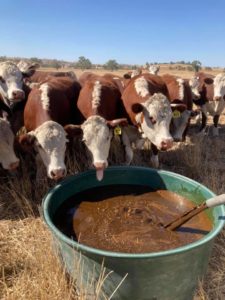Key Points:
- A weaker cattle market has put the spotlight on production efficiency.
- The most cost effective (efficient) feed is what is growing in your paddock when used well.
- For a cost of around $2.70/hd/week dry feed + StockGro-HiPro can provide maintenance for dry cows.
Before buying expensive hay assess the quality and quantity of your standing feed. Can you better utilise this feed for the growth and maintenance of different classes of cattle? Similarly, if you must buy in feed for maintenance of dry cows, is there a cheaper alternative that can do the same job?
Efficiency has been the buzzword for graziers in 2023, with tough marketing conditions putting a spotlight firmly on the cost of production once again. At the same time, and despite the recent widespread rainfall, the onset of hotter and drier seasonal conditions over the past month or so may be a sign that we’re moving towards the El Nino that the BOM have been forecasting for the past six months. As the dry period gets closer and producers plan dry season feeding activities, it is valuable to assess the feeding options and the costs associated with each.
“If farmers have silage or hay available, it is better used to feed their growers than used to provide maintenance in dry cows”
Micheal Savli ANP Technical Support Manager/Nutritionist
Hay is not a cost effective dry season feed
It goes without saying that the most cost-effective feed in any season is home-grown feed, with efficiency gained in the matching of feed value with the class of livestock. AusFarm Nutrition Products (ANP) have run the numbers in a cattle operation, and at current prices, feeding cereal hay to growing cattle can be up to 10 times more expensive than effectively utilising dry pasture by supplementing with StockGro-HiPro. Similarly in dry cows, maintenance feeding with hay is up to 7 times more expensive than supplementing with StockGro-HiPro while grazing stubbles and almost double the cost of feeding StockGro-HiPro and buying in barley straw.
ANP’s Technical Manager, Micheal Savli, has been working with producers on comparing the cost of providing production and maintenance to cattle during the dry season. The table below is a comparison of the costs associated with adopting four different dry season feeding options to satisfy low level growth and maintenance.
Cost Comparison of Different Dry Season Feeding Options

Home-grown forages are the most efficient dry season feed when paired with a supplement
For dry cows looking to maintain condition through the dry period, the greatest efficiency is achieved by grazing home-grown stubbles and supplementing with StockGro-HiPro for a cost of 38c/hd/day or $2.70/week. Monitor feed availability and plan for alternatives if feed becomes limited.
For lactating cows, Stubbles or low value pasture is also recommended when supplemented with StockGro-HiPro + Bovatec®. The Bovatec® can generate greater feed use efficiency, support lactation and boost calf growth and immunity. Cows should be in good condition (Body Condition Score 3.5+) since, due to the increased milk production they will likely lose weight as the calves grow. When controlled this not a bad thing, especially for spring calvers in association with early weaning.
If grazing forage is limiting, buy in straw
Where the quantity of home-grown forage is limited, maintenance in dry cows and improved performance of lactating cows can be achieved efficiently by feeding good quality straw (barley straw) or moderate quality hay and supplementing it with StockGro-HiPro, or StockGro-HiPro + Bovatec®, respectively. According to the Hay Prices indicator reported in The Land on November 7th, 2023, mid-quality barley straw can be bought for $110/tonne delivered on-farm.
An improved pasture, like ryegrass, in its early dry stage, where there are plenty of leaves still on the plants, can be most efficiently utilised by grazing with producing animals (steers, heifers and lactating and late pregnant cows) when supplemented with StockGro-HiPro or StockGro-HiPro + Bovatec®. A word of caution – the value of standing dry feed significantly declines when leaves drop from the plant or when rained on. It is important to monitor dry feed and re-assess its production capacity while grazing and following rain events. Furthermore, on the back of a few high-producing seasons, ANP is expecting the quality of dry pasture to be lower than usual. To make best use of dry pasture for production purposes, supplement with StockGro-HiPro early and make the most of the pasture before it’s reduced to dry stalks and stems or its quality diminishes following rain.
Feeding hay is the least efficient option assessed and really should only be offered to producing cattle when quality and/or quantity of dry pasture is lacking. For a producer feeding hay to growing cattle, the measure of efficiency comes back to production goals and where individuals think the market is going to be come sale time.
What is StockGro-HiPro?
ANP’s liquid StockGro-HiPro supplement is designed to correct protein, energy and mineral deficiencies and maximise the health and performance of cattle on mature dry feed and stubbles. StockGro-HiPro achieves this by supplying several sources of rumen degradable protein in the forms of urea and ammonium salts (non-protein nitrogen) and a range of essential minerals, vitamins and trace elements delivered on a little and often basis. Furthermore, the growth in rumen micro-flora elevates fibre digestion, thus allowing for greater feed conversion efficiency of stubbles and dry feeds.
Bovatec for extra production
For an additional boost, Bovatec®, a highly cost-effective and safe ‘Ionophore’ feed additive, can be optionally included. Bovatec® promotes the growth of certain beneficial rumen bacteria for improved rumen performance while controlling coccidiosis-causing parasites that affect calves. Together, these benefits allow for optimal nutrient utilisation, animal production and milk yield for lactating cows while delivering effective animal welfare solutions.
Contact us to help plan for the dry season and manage the efficiency of your dry season feeding.